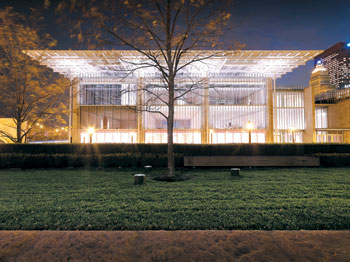
INSIGHTFUL CONVERSATIONS... START HERE
Union Electricians Play a Critical Role in Art Institute’s New West Wing

A masterpiece of modern architecture, the Art Institute of Chicago's West Wing required the mastery of skilled union electricians. Chicago is accustomed to shouldering both classic and contemporary architecture, but rarely do the two unite in such arresting contrast as the Art Institute of Chicago and its adjoining 264,000-sq.-ft. Modern Wing, set for completion this May.
The addition, located adjacent to Millennium Park, sweeps in on an aluminum "flying carpet," a decidedly modernist flourish suspended over the wing's upper-floor galleries.
It's a fitting approach to a building that houses contemporary art, but one that proved problematic during the project's 10-year gestation, says Mike McLean, project manager with Skokie, Ill.-based Continental Electrical Construction Co. (CECCO), the wing's electrical contractor.
"The project was subject to hundreds of bulletins," McLean recalls. "Some called for small design changes, others for large." McLean attributes the changes not only to the complexity of design, which incorporates cutting-edge life-safety, security, lighting and mechanical controls, but also to the amount of time that lapsed between the completion of design and start of construction. Like the project's flying carpet, base building systems are a moving target, subject to change as new technologies become available, he says. The project would not allow off-the-shelf, pre-fabricated solutions. Many were designed and built on the fly, and therefore the project required the training and skill sets you expect from a union-based workforce. During peak construction periods, there were as many as 50 union electricians on site, a testimony to the scale and complexity of the project.
Electricians found themselves contending with three distinct but interlocking structures: a three-story east pavilion for galleries and museum education; Griffin Court, a double-height space to enhance circulation; and a three-story west pavilion housing galleries, visitor services, a sculpture terrace and a dining facility.
Different uses for each of the three buildings dictated different design solutions, compounding the complexity of the project, McLean says.
The common denominator was a lack of space for mechanical, electrical and plumbing systems, a condition resulting from the transparency of the design, according to McLean. "We didn't have many furred out walls, so we had to spend quite a bit of time coordinating with the mechanical and plumbing contractors," he says. "We employed the floor slabs to the extent possible and then began to look for mechanical corridors and similar avenues to accommodate the remaining conduits." Unique systems and applications were the order of the day. In addition providing a bold signature, the flying carpet functions as a sunscreen, complete with computermodeled wings to ensure underlying skylights deliver appropriate amounts of lighting to assorted galleries. The screen allows the color of light to shine through but not the heat loads typically associated with glass. In addition, the screen incorporates programmable electrical blinds, as well as a base-board heating system on the third floor to keep the glass overhead from condensing.
Other systems are more common to computer rooms and data centers than museums. "An air sampling conduit in the ceiling continually tests for any air particles that denote the presence of smoke," McLean says. "The objective is early detection so that museum operators can avoid dousing spaces with water and potentially damaging valuable collections."
Even before completion, the Modern Wing is capturing attention from near and far. The New York Times recently ranked the facility No. 14 on its 2009 list of 44 must-see attractions worldwide. Like so many buildings belonging to Chicago's vast architectural heritage, look for the Modern Wing to become as prized for its remarkable design as it is for its enduring functions — all supported by state-of-the-art electrical systems built by a highly-skilled union electrical workforce.




